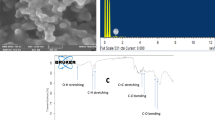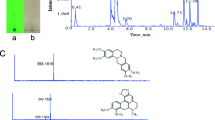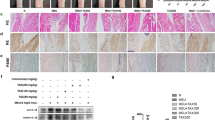Abstract
Gouty arthritis is characterized by inflammation induced by monosodium urate (MSU) crystal deposition, which is resulted by an increase of serum urate concentration. The management of gout, especially the recurrent acute attacks of chronic gouty arthritis, is still a problem to be resolved. In this study, we aimed to develop the preventive and therapeutic effect of resveratrol on gouty arthritis. MSU was used to induce gouty arthritis in the foot pad of C57BL/6 mice. Yeast polysaccharide and potassium oxonate were used to induce hyperuricemia in Kunming mice. Resveratrol was intraperitoneal injected to the mice in the treatment group. The pad inflammation and the level of serum uric acid were investigated to estimate the effect of resveratrol in gouty arthritis. Hyperuricemia was significantly detected in the mice treated with yeast polysaccharide and potassium oxonate, and gouty arthritis was successfully induced with MSU in mice. We further identified that resveratrol inhibited pad swelling and pad 99mTc uptake in gouty mice. Moreover, serum uric acid level was also decreased by resveratrol in hyperuricemia mice. This study highlighted that resveratrol might be applied to prevent the recurrent acute attack of gouty arthritis because of its inhibition of articular inflammation and down-regulation of serum uric acid.




Similar content being viewed by others
References
Khanna D, Fitzgerald JD, Khanna PP, Bae S, Singh MK, Neogi T et al (2012) American College of Rheumatology guidelines for management of gout. Part 1: systematic nonpharmacologic and pharmacologic therapeutic approaches to hyperuricemia. Arthritis Care Res (Hoboken) 64:1431–1446
Khanna D, Khanna PP, Fitzgerald JD, Singh MK, Bae S, Neogi T et al (2012) American College of Rheumatology guidelines for management of gout. Part 2: therapy and antiinflammatory prophylaxis of acute gouty arthritis. Arthritis Care Res (Hoboken) 64:1447–1461
McGettrick AF, O’Neill LA (2013) How metabolism generates signals during innate immunity and inflammation. J Biol Chem 288:22893–22898
Doherty M, Jansen TL, Nuki G, Pascual E, Perez-Ruiz F, Punzi L et al (2012) Gout: why is this curable disease so seldom cured? Ann Rheum Dis 71:1765–1770
Rodevand E, Sletvold O, Kvande KT (2004) Side effects off allopurinol. Tidsskr Nor Laegeforen 124:2618–2619
Hilmi BA, Asmahan MI, Rosman A (2012) Use of newly available febuxostat in a case of chronic tophaceous gout contraindicated to allopurinol and probenecid. Med J Malays 67:125–126
Borra MT, Smith BC, Denu JM (2005) Mechanism of human SIRT1 activation by resveratrol. J Biol Chem 280:17187–17195
Howitz KT, Bitterman KJ, Cohen HY, Lamming DW, Lavu S, Wood JG et al (2003) Small molecule activators of sirtuins extend Saccharomyces cerevisiae lifespan. Nature 425:191–196
Lagouge M, Argmann C, Gerhart-Hines Z, Meziane H, Lerin C, Daussin F et al (2006) Resveratrol improves mitochondrial function and protects against metabolic disease by activating SIRT1 and PGC-1alpha. Cell 127:1109–1122
Bishayee A, Waghray A, Barnes KF, Mbimba T, Bhatia D, Chatterjee M et al (2010) Suppression of the inflammatory cascade is implicated in resveratrol chemoprevention of experimental hepatocarcinogenesis. Pharm Res 27:1080–1091
Zhu X, Liu Q, Wang M, Liang M, Yang X, Xu X et al (2011) Activation of Sirt1 by resveratrol inhibits TNF-alpha induced inflammation in fibroblasts. PLoS One 6:e27081
Elmali N, Baysal O, Harma A, Esenkaya I, Mizrak B (2007) Effects of resveratrol in inflammatory arthritis. Inflammation 30:1–6
Wang KT, Chen LG, Tseng SH, Huang JS, Hsieh MS, Wang CC (2011) Anti-inflammatory effects of resveratrol and oligostilbenes from Vitis thunbergii var. taiwaniana against lipopolysaccharide-induced arthritis. J Agric Food Chem 59:3649–3656
Post AM, Katsikis PD, Tait JF, Geaghan SM, Strauss HW, Blankenberg FG (2002) Imaging cell death with radiolabeled annexin V in an experimental model of rheumatoid arthritis. J Nucl Med 43:1359–1365
Carroll JJ, Coburn H, Douglass R, Babson AL (1971) A simplified alkaline phosphotungstate assay for uric acid in serum. Clin Chem 17:158–160
Joosten LA, Netea MG, Fantuzzi G, Koenders MI, Helsen MM, Sparrer H et al (2009) Inflammatory arthritis in caspase 1 gene-deficient mice: contribution of proteinase 3 to caspase 1-independent production of bioactive interleukin-1beta. Arthritis Rheum 60:3651–3662
Joosten LA, Abdollahi-Roodsaz S, Heuvelmans-Jacobs M, Helsen MM, van den Bersselaar LA, Oppers-Walgreen B et al (2008) T cell dependence of chronic destructive murine arthritis induced by repeated local activation of Toll-like receptor-driven pathways: crucial role of both interleukin-1beta and interleukin-17. Arthritis Rheum 58:98–108
Palsamy P, Subramanian S (2008) Resveratrol, a natural phytoalexin, normalizes hyperglycemia in streptozotocin-nicotinamide induced experimental diabetic rats. Biomed Pharmacother 62:598–605
Bruckbauer A, Zemel MB, Thorpe T, Akula MR, Stuckey AC, Osborne D et al (2012) Synergistic effects of leucine and resveratrol on insulin sensitivity and fat metabolism in adipocytes and mice. Nutr Metab (Lond) 9:77
Kojima K, Ohhashi R, Fujita Y, Hamada N, Akao Y, Nozawa Y et al (2008) A role for SIRT1 in cell growth and chemoresistance in prostate cancer PC3 and DU145 cells. Biochem Biophys Res Commun 373:423–428
Jung-Hynes B, Ahmad N (2009) Role of p53 in the anti-proliferative effects of Sirt1 inhibition in prostate cancer cells. Cell Cycle 8:1478–1483
Salminen A, Ojala J, Huuskonen J, Kauppinen A, Suuronen T, Kaarniranta K (2008) Interaction of aging-associated signaling cascades: inhibition of NF-kappaB signaling by longevity factors FoxOs and SIRT1. Cell Mol Life Sci 65:1049–1058
Knobloch J, Sibbing B, Jungck D, Lin Y, Urban K, Stoelben E et al (2010) Resveratrol impairs the release of steroid-resistant inflammatory cytokines from human airway smooth muscle cells in chronic obstructive pulmonary disease. J Pharmacol Exp Ther 335:788–798
Chung EY, Kim BH, Hong JT, Lee CK, Ahn B, Nam SY et al (2010) Resveratrol down-regulates interferon-gamma-inducible inflammatory genes in macrophages: molecular mechanism via decreased STAT-1 activation. J Nutr Biochem 22:902–909
Wu XW, Muzny DM, Lee CC, Caskey CT (1992) Two independent mutational events in the loss of urate oxidase during hominoid evolution. J Mol Evol 34:78–84
Bomalaski JS, Clark MA (2004) Serum uric acid-lowering therapies: where are we heading in management of hyperuricemia and the potential role of uricase. Curr Rheumatol Rep 6:240–247
Hirai A, Kumagai A (1982) Animal model for gout. Jikken Dobutsu 31:143–151
Chen L, Yin H, Lan Z, Ma S, Zhang C, Yang Z et al (2011) Anti-hyperuricemic and nephroprotective effects of Smilax china L. J Ethnopharmacol 135:399–405
Xu WA, Yin L, Pan HY, Shi L, Xu L, Zhang X et al (2013) Study on the correlation between constituents detected in serum from Rhizoma Smilacis Glabrae and the reduction of uric acid levels in hyperuricemia. J Ethnopharmacol 150:747–754
Acknowledgments
This work was supported by the Major Project of Shanghai Science and Technology Foundation (NO. 11DJ1400101) and the National Natural Science Foundation of China (No. 81302573). The funders had no role in study design, data collection and analysis, decision to publish, or preparation of the manuscript.
Disclosures
None.
Author information
Authors and Affiliations
Corresponding author
Additional information
Haiyan Chen and Shucong Zheng contributed equally to this paper
Rights and permissions
About this article
Cite this article
Chen, H., Zheng, S., Wang, Y. et al. The effect of resveratrol on the recurrent attacks of gouty arthritis. Clin Rheumatol 35, 1189–1195 (2016). https://doi.org/10.1007/s10067-014-2836-3
Received:
Revised:
Accepted:
Published:
Issue Date:
DOI: https://doi.org/10.1007/s10067-014-2836-3




